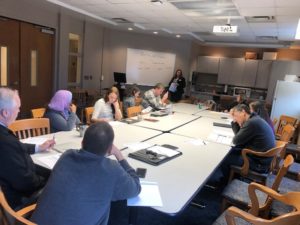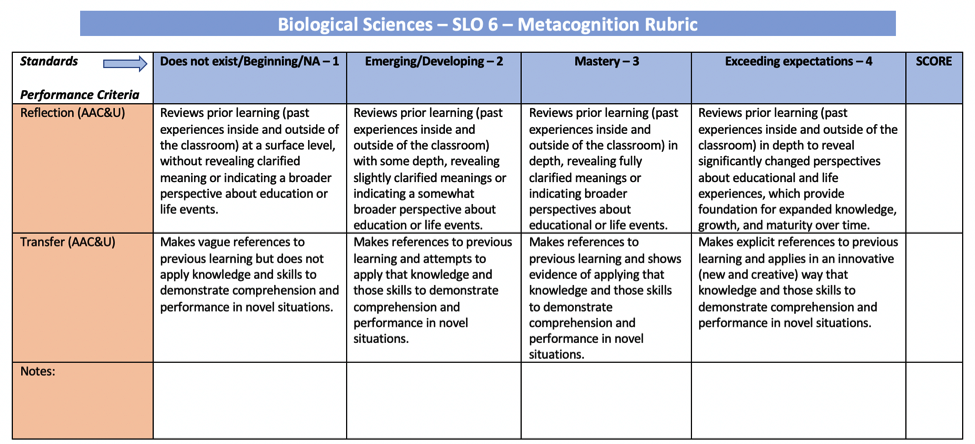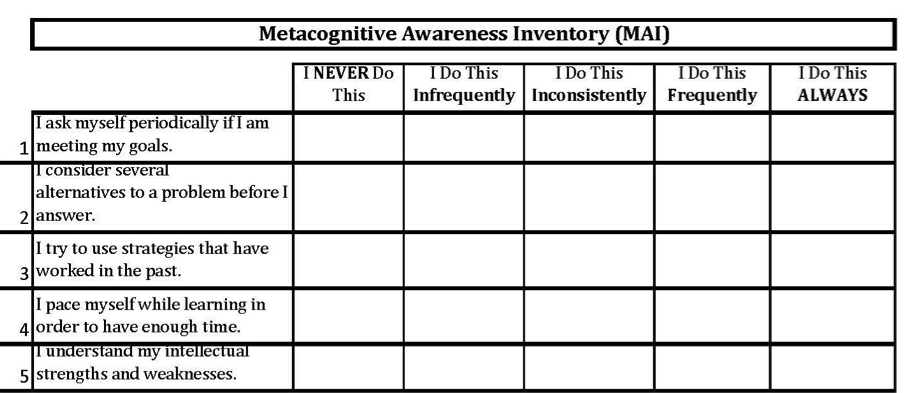In the fourth post of “The Evolution of Metacognition in Biological Sciences” guest series, Dr. Lindsay Doukopoulos describes the goals and outcomes of the spring meetings of the Biology curriculum committee that were led by Biggio Center and the Office of Academic Assessment. Namely, they sought to create a questionnaire that would be given to all graduating students that would allow them reflect on their learning over the course of their academic career and to create a rubric to measure the quality of metacognition in their responses.
by Dr. Lindsay Doukopoulos, Assistant Director of the Biggio Center for the Enhancement of Teaching and Learning. In collaborating with the Office of Academic Assessment on the Learning Improvement Initiative, she leads faculty development initiatives designed to connect faculty with strategies, resources, and partners to support their teaching.
In Spring of 2019, Katie Boyd and I led four meetings with Biology’s curriculum committee with the two-part goal of producing a set of metacognitive-reflection questions to be completed by every graduating student in their capstone course and a rubric to assess the quality of metacognition evidenced in the reflections.
Developing the Rubric
In the first workshop, our goal was to help faculty unpack the definition of metacognition into categories and decide how many levels or standards to maintain within the rubric. In other words, we were hoping to fill in the x and y axes of the Metacognition rubric.
To facilitate this discussion, we brought two rubrics designed to measure metacognition. One came from the General Learning Outcome site of Cal State University-San Bernardino (CSUSB). The other came from the AAC&U Value rubric on Lifelong Learning, specifically, the two elements called Transfer and Reflection. Both rubrics appeared to offer valuable ways of assessing the metacognition evident in a written reflection. Rather than choose one or the other, we combined the two categories (rows) of the AAC&U Value rubric and the three categories (rows) of the CSUSB rubric. We also decided to use four standards of quality (columns) and discussed terminology resulting in: Beginning or N/A, Emerging/Developing, Mastery, and Exceeding Expectations.

In the second workshop, our goal was to fill in the performance criteria or behavioral anchors that would make up the rubric. After much discussion, we again decided to leave the rubric big and pilot it in our next meeting to determine whether the AAC&U elements or the CSUSB elements would be preferable.
In our third workshop, piloted the rubric by we scoring a packet of student reflections that had come out of the Biology undergraduate research capstone course the previous year. In practice, the faculty found the two elements of the AAC&U rubric easier to apply and more valuable for differentiating between the quality of metacognition in the student responses. Thus, we reduced the final rubric to those two elements.

Developing the Reflection Questions
In the final workshop, our goal was to draft and finalize questions that would be given to sophomores and seniors in the program. These questions would parallel those already being used in the undergraduate research capstone course. These are the questions the committee created:
- What has been your favorite learning moment in your major? Please describe it in detail and explain why it was your favorite.
- What were the most useful skills you learned in your major and why?
- Regarding the skills you listed in question 2: how do you know you learned them? Please provide specific examples.
- How do you plan to apply these skills in future courses or your career?
- As a student, what could you have done to learn more? If you could go back in time and give yourself advice, what you say?
- Evaluate your capacity to design an experiment and generate hypotheses. Please provide specific examples of aspects of the scientific process you’re most and least confident about.
- Reflect on your view of science. How has your participation in your Biological Sciences major changed your view of science, if at all? Please provide specific examples.
- Reflecting on your learning journey, what do you value most about your major curriculum (i.e. the courses you took and the order you took them in)?
This question-writing process concluded the initial phase of the Learning Improvement Initiative as it led to the creation of the instrument the department will use to gather baseline data on the metacognition SLO. Moving forward, all students (roughly 75 majors per year) will complete the questionnaire during their capstone course and the curriculum committee will lead assessment using the rubric we created.
The goal is to have every student scored on the rubric every year beginning with baseline data collection in spring 2020 with students who have not experienced the “treatment” conditions, i.e. courses redesigned by faculty to improve metacognition. Over time, we expect that the faculty development workshops around transparent assignment design, reflective writing assignments, and ePortfolio pedagogy will result in graduates who are more metacognitive and data that reflects the learning improvement.
